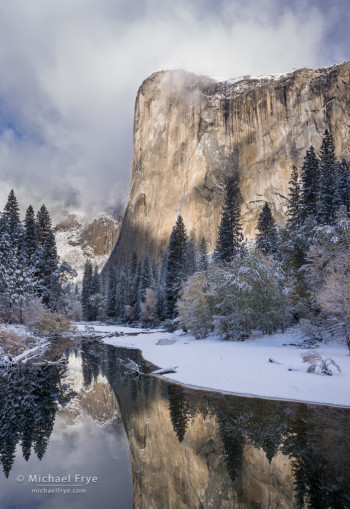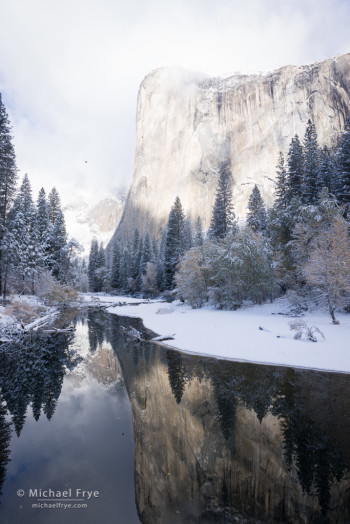Many people have been asking me for a sequel to Light & Land, my first eBook about processing landscape photographs. Well I’m very pleased to announce that it will be coming soon – this week in fact!
This photograph of El Capitan is one of the examples in the new eBook. It was a high-contrast scene; you can see the original, unprocessed Raw file below, with its inky shadows and washed-out highlights. In the past, a scene like this might have required using HDR, or blending exposures manually in Photoshop.
But I didn’t use HDR, or any kind of exposure blending, to make the final image you see here; it’s just one image, processed entirely in Lightroom. In the new eBook I show you exactly how I went from that original Raw file to the finished version – and how you can do that with your own photographs.
There are more step-by-step examples in the eBook, and a lot of other exciting features. I’ll tell you all about it soon – stay tuned!
In the meantime, if you haven’t seen it yet, you might want to watch the video I made last year about the tone controls in Lightroom. It’s been very popular, with over 36,000 views on YouTube — an amazing total for a 25-minute how-to video about such a specialized subject. Thanks to all of you who’ve watched; I really appreciate the support!
— Michael Frye
Michael Frye is a professional photographer specializing in landscapes and nature. He is the author and photographer of The Photographer’s Guide to Yosemite, Yosemite Meditations, and Digital Landscape Photography: In the Footsteps of Ansel Adams and the Great Masters, plus the eBooks Light & Land: Landscapes in the Digital Darkroom, and Exposure for Outdoor Photography. He has written numerous magazine articles on the art and technique of photography, and his images have been published in over thirty countries around the world. Michael has lived either in or near Yosemite National Park since 1983, currently residing just outside the park in Mariposa, California.











Michael:
Looking forward to buying your new e-book. Everything you produce is of the highest quality and instructional value.
Kevin Brown
Thanks Kevin! I appreciate the kind words, and hope you like the new eBook.
Can’t wait!
Thanks Rick!
Michael, my life has been topsy turvy (in a mostly good way), and I missed your last 3 posts but got a quick look at those this week and bookmarked them because I was enthralled by the beauty of so many subtle elements that, put together, resulted in images that actually seemed 3-dimensional to me, a wholly unexpected experience. Just gorgeous, way beyond the garishness so prevalent today.
I’ll be buying any book you write. Thanks for all your work explaining what you do.
– Andrys
Thanks very much Andrys! I do hope that the topsy-turvy thing is mostly good for you, and I appreciate your kind words.
I just downloaded it from C&V, looks great!
Danielle
Thanks Danielle, but that must be a different book. This will be my first self-published eBook, so it won’t be sold through Craft & Vision. I’m doing this myself so that I can offer some features I can’t offer through C&V. More news soon!
Dear Michael,
You work in and write about Lightroom. I use CS5 and wonderes in my niavity to what extent they are similar.I like some of your recent abstract work and I try to encourage folk to try this approach,
Tjhanks for your L&L and the e booklets,
Best regards,
Ian
Thanks Ian. Photoshop CS5 and Lightroom and similar and different — how’s that for an answer? 🙂 The biggest similarity is that Lightroom is essentially a combination of Bridge and Adobe Camera Raw, except that Lightroom’s Library Module is much better and faster than Bridge, and it’s great to have these functions integrated into one program. Of course Photoshop proper has lots of features that Lightroom and ACR don’t have, but then again, most of the things that most photographers usually do can be done in Lightroom or ACR. And Lightroom/ACR have become even more powerful since CS5. The upgrade from Lightroom 3 to 4, and from ACR 6 to 7, were probably the biggest upgrades in Adobe’s Raw-processing engine ever.
Question about self-publishing an illustrated e-book. I’m a professional artist who wishes to e-publish a highly illustrated 36,000 word novella. Where can I find a tutorial on exactly how to do that, given the various platforms out there? Words are no problem…it’s the illustrations. Any help would be appreciated.
Thanks!
Ann
Ann, I’m hardly an expert on this. My new ebook is a PDF, and for that you can either hire a designer or try to learn the ins and outs of InDesign or Quark XPress yourself. The various epub formats are something I’ll be looking into in the future. You might find some good information on Pat Flynn’s site: SmartPassiveIncome.com.
Hi Micheal,
Just now purchased the e-book, and I have to say it looks like a bargain – even before the discount. You could probably charge twice as much and still sell as many! I look forward to spending some quality time with it and your sample files (not to forget the videos). Did I mention already it’s a bargain?
Robert
Thanks Robert — glad you think it’s a bargain! Let me know what you think when you’ve had a chance to dive into it more.
Michael:
The book is available now? I didn’t see a link on your page.
Kevin, I made it available today to people on my mailing list. But no worries, it’ll be available to everyone tomorrow morning!
Great! I just signed up for your newsletter too!
Michael Frye’s photographs on my computer – I’m thrilled.
And I do love when you write: “The most powerful tool in the digital darkroom is your eye. The most amazing software tools are useless if you don’t know … how you want your image to look.”
Your e-book is a great help to process raws and end up with images which transport the photographer’s vision.
Thanks a lot.
Marie
Marie, thanks very much for all the kinds words. I really appreciate that, and I’m glad you like the new ebook!
Michael…I’m excited about your new ebook. I’m a relatively new subscriber to your blog. I have purchased both Light and Land and your new book. You mentioned that your new book is a sequel to Light and Land. If that is the case, should I read it before your new book? Thanks…Karen
Thanks Karen. Lightroom has changed a lot since I wrote Light & Land, so if you’re using Lightroom 4 or 5, the new ebook Landscapes in Lightroom 5 is more relevant, and you don’t need to read Light & Land first.
Thanks for your reply, Michael. Looking forward to digging into the new book. Karen